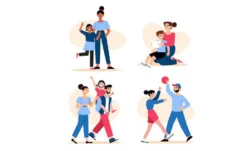Children are vulnerable in nature and need maximum protection, not just from family and relatives, but also from the government. Laws that mitigate abusive behaviours protect children, covering their basic rights for a normal, safe, healthy, and happy life. The alarming increase in child abuse in the UK highlights the importance of child protection orders to safeguard their well-being. It is not unusual for households with domestic violence that children suffer from physical, mental, verbal, psychological, or sexual abuse. This is when child protection orders come in full force.
What are child protection orders?
Child protection orders are designed to protect the child from an abusive family member or any person who intentionally harms him. They are also applicable in cases where the child’s basic needs are neglected. After a thorough review of the pieces of evidence and testimonies from credible people, the court may issue any of the following child protection orders:
- Interim care orders (ICO) – They give parental responsibility to the local authority or social workers to place the child in the care of a carer or anyone in his extended family like a grandparent, aunt, or uncle.
- Interim supervision orders (ISO)- The type of orders that place the child under the local authority’s supervision, but allow the parents or guardians to have parental responsibility.
- Emergency protection orders (EPO) – In exceptionally serious situations, the court issues an EPO to allow the local authority to remove the child from the present home environment along with limited parental responsibility for the child. The order takes effect for up to 8 days and can be extended for another 7 days if the court sees the danger is still present.
- Child assessment orders – These orders instruct the parents to make sure that the child is available for psychiatric, medical, or social work assessments when the court says it is necessary for the case.
Who is allowed to apply for child protection orders?
Anyone can apply for child protection orders if they believe that the child is neglected, ill-treated, or abused in ways that cause significant harm or likely to harm him.
- A biological parent
- A family member
- A guardian
- A grandparent
- Local authority or social worker
- NSPCC
- Police
- Any person who has shared parental responsibility for the child
How to file for a child protection order?
To obtain any of the child protection orders, the applicant should fill out a form, petition for the order, and file it to the court. The petitioner needs to prove that there is a valid reason for getting a child protection order. It involves submitting assessments, witness testimonies, and other pertinent evidence that will support your request. From there, the court will review the request and the supporting documents and make a decision to grant or deny the request.
Why is there a need for child assessment?
If after the enquiries, the evidence shows that the child is suffering significant harm or likely to suffer significant harm, the court and the parties involved in the case can decide to know more about the situation of the child. This may result in a series of assessments conducted by an independent expert agency. The parents, guardians, social services, and other qualified individuals will be asked to share their insights. The court will assess the report and use it to make a decision.
Are child protection conferences necessary?
Child protection conferences (CPCs) are arranged by the social services to pool information and discuss any relevant issues and concerns of people who care for the child.
- Parents
- Guardians and carers
- Family members
- Older siblings
- Teachers, doctors, and other professionals who are involved with the child
Social services
The child, if he is old enough to understand the situation
If the parent or carer of the child does not want to attend the conference or is unable to do due to some circumstances, it will be fine. However, it will leave an impression of unwillingness to cooperate or engage and affect the assessment of the threshold. Hence, it is necessary to attend all the conferences to show good faith and willingness to the process.
The meeting should be held within 15 working days of the strategy discussion. If during the culmination of the conference or a series of conferences, there is a finding that the child is likely to suffer significant harm in the future, the group will come up with a child protection plan.
A child protection plan details the actions that need to be taken, by whom and by when to ensure that the child is safe. It would be reviewed regularly during the conferences until he is safe or taken into care. If needed, it will be updated to guarantee his safety in the future.
On the other hand, if there are serious circumstances like sexual abuse, physical abuse, emotional abuse, physical injury, domestic violence, harm, or neglect, the case can go to legal planning with the possibility of issuing court proceedings. During the proceedings, the parents and carers of the child will be given a chance to explain or defend themselves. They would be needing legal assistance to ensure that they fully understand the process and the documentation necessary for child protection.
What happens when the request is granted?
Once granted, the applicant has the right to remove the child from his present home and take him to a safe place. If the child is already placed in a safe place like a hospital, child centre, or a residence of anyone who shares parental responsibility, the order will prevent the parent or carer from taking him away. The parent can file for a recall of the child protection order with the help of a family solicitor.
Anyone who violates child protection orders can be arrested and faced a criminal offence. Violating a child protection order can result in both civil and criminal penalties. If the order carries some criminal consequences, the violator can be charged with a misdemeanour, contempt of a court order, or felony. It would mean conviction and heavy fines.
Image Credit: https://unsplash.com/photos/VZILDYoqn_U







